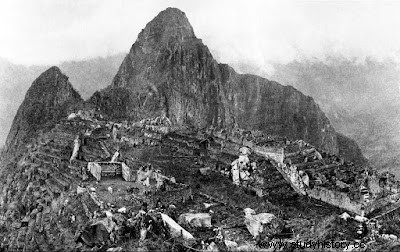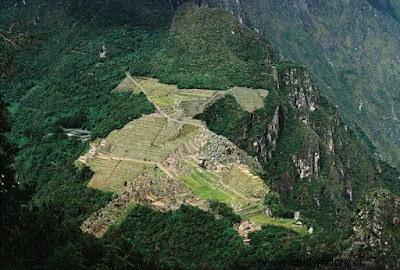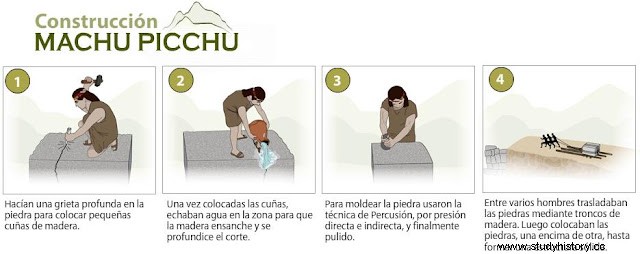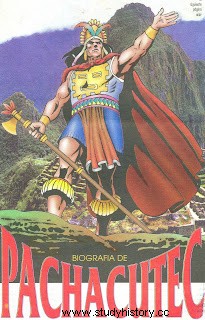Machupicchu, that beautiful and magical citadel built on top of a mountain in Peru, has made history in the world since its "discovery" by the American professor Hiram Bingham and, even more so, since it was recognized as a World Wonder. However, his true story remained, until now, unknown. Only the architectural structure of the citadel was studied and investigated, its construction was attributed, without further evidence, to the Inka Pachakuteq and there was much speculation about its origin, functions and decline. It is currently being debated whether it is the private property of some rich farmers from Cusco or if it is a cultural asset that belongs to the Peruvian State.
 First image taken at the time of its "discovery" by the National Geographic Society Today I allow myself to present to the people of Peru the first result of my research on the real history of Machupicchu where I basically try to demonstrate three hypotheses:1) That it was the Inka Wiraqocha who ordered the construction of Machupicchu and not the Inka Pachakuteq. 2) That it fulfilled an eminently religious function since it was the “sacred mansion” and temporary of the God-King Wiraqocha; and 3) that its decline was due to the order of the Inka Pachakuteq for its depopulation, its abandonment and its perpetual oblivion. To arrive at these new approaches, it has been necessary to know and investigate the life and work of the Inca kings of Peru from the mythical Manco Kapac to Tupac Amaru II and, for the specific case of Machupicchu, delve into the life of Titu Kusi Wallpa, Quichka Tupac and Titu Kusi Yupanqui. The long journey in the biography of the Inca rulers (See my book:The Inca Kings of Peru ) allowed me to envision, by “separate rope”, the real history of Machupicchu.
First image taken at the time of its "discovery" by the National Geographic Society Today I allow myself to present to the people of Peru the first result of my research on the real history of Machupicchu where I basically try to demonstrate three hypotheses:1) That it was the Inka Wiraqocha who ordered the construction of Machupicchu and not the Inka Pachakuteq. 2) That it fulfilled an eminently religious function since it was the “sacred mansion” and temporary of the God-King Wiraqocha; and 3) that its decline was due to the order of the Inka Pachakuteq for its depopulation, its abandonment and its perpetual oblivion. To arrive at these new approaches, it has been necessary to know and investigate the life and work of the Inca kings of Peru from the mythical Manco Kapac to Tupac Amaru II and, for the specific case of Machupicchu, delve into the life of Titu Kusi Wallpa, Quichka Tupac and Titu Kusi Yupanqui. The long journey in the biography of the Inca rulers (See my book:The Inca Kings of Peru ) allowed me to envision, by “separate rope”, the real history of Machupicchu.Let's examine the first hypothesis.
In the first place, the construction of Machupicchu began approximately between the years 1385-86, that is, when Pachakuteq (1387-1471) was still a child. Its construction must have lasted some 20 or 30 years of hard work by thousands of enslaved peasants (Yanakunas and mitmakunas).
Secondly, and this evidence is irrefutable, Wiracocha the Inka adopted as his ascendant and protector (Totem) the Condor, a majestic and traditional bird of the Peruvian Andes and had it represented and worshiped in Cusco in a rock called “Kunturqaqa” (The Rock of the Condor) as described by Garcilaso in his Royal Comments. Likewise, he ordered his architects and engineers to design the construction of the citadel at the top of the "old hill" giving it the shape of the aforementioned Andean bird as can be seen in the photographs taken from the top of Wayna Picchu. He also ordered the construction, near the Temple of the Sun, of a temple dedicated especially to the veneration of the bird (The Temple of the Condor).
 The Wiracocha Condor. Panoramic shot of Machupicchu Let's take a brief look at the biography of the Inca Wiracocha (1355-1435). He was the eighth ruler of the State of Cusco and his parents were Yawar Waqaq and Choque Chiqlla Yupay. His original name was Kichka Tupac (Blas Valera). He was erected king of Cusco after the assassination of his father by the insurrectionary Condesuyos. After fully assuming power, he began the political-military expansion of his State towards the north of Cuzco, reaching a strange place where he observed the existence of three hills:One small, another very steep and the third semi-flat:he called them Uchuy Picchu (Cerro small), Wayna Picchu (Young Hill) and Machu Picchu (Old Hill) respectively. Back in Cusco after his successful conquests and having extended his State, he changed his name to Qatun Tupac (Tupac the Great). After approximately 10 years of having consolidated his power in Cusco and having renovated the city, he called himself Wiracocha, arguing that the same main God of the Inkas had appeared to him in dreams and designated god on earth, authorizing him to adopt his own name. That is, by his own decision he became God and King at the same time. It was during those years that he devised, planned and ordered the construction of a sacred citadel, in honor of the God Wiracocha, himself, destined for his tranquility and rest (Aukasamana). He ordered the construction of a beautiful temple-palace for him, temples for the sun god, for the condor, etc.; special rooms for priests and priestesses (Aqllakuna) at the service of the sun god and the Inca; rooms for astronomers, engineers and architects, etc. In the surroundings small barracks were erected for the Inka's guard and for the custody of the citadel. This is how what we know today as the magical and mysterious citadel of Machupicchu arose and reached its apogee.
The Wiracocha Condor. Panoramic shot of Machupicchu Let's take a brief look at the biography of the Inca Wiracocha (1355-1435). He was the eighth ruler of the State of Cusco and his parents were Yawar Waqaq and Choque Chiqlla Yupay. His original name was Kichka Tupac (Blas Valera). He was erected king of Cusco after the assassination of his father by the insurrectionary Condesuyos. After fully assuming power, he began the political-military expansion of his State towards the north of Cuzco, reaching a strange place where he observed the existence of three hills:One small, another very steep and the third semi-flat:he called them Uchuy Picchu (Cerro small), Wayna Picchu (Young Hill) and Machu Picchu (Old Hill) respectively. Back in Cusco after his successful conquests and having extended his State, he changed his name to Qatun Tupac (Tupac the Great). After approximately 10 years of having consolidated his power in Cusco and having renovated the city, he called himself Wiracocha, arguing that the same main God of the Inkas had appeared to him in dreams and designated god on earth, authorizing him to adopt his own name. That is, by his own decision he became God and King at the same time. It was during those years that he devised, planned and ordered the construction of a sacred citadel, in honor of the God Wiracocha, himself, destined for his tranquility and rest (Aukasamana). He ordered the construction of a beautiful temple-palace for him, temples for the sun god, for the condor, etc.; special rooms for priests and priestesses (Aqllakuna) at the service of the sun god and the Inca; rooms for astronomers, engineers and architects, etc. In the surroundings small barracks were erected for the Inka's guard and for the custody of the citadel. This is how what we know today as the magical and mysterious citadel of Machupicchu arose and reached its apogee. Hypothesis on the Construction of Machu Picchu But there were few years that the god-king Wiracocha was able to enjoy the benefits of the "sacred city". His son Prince Kusi Yupanqui after his circumstantial conversion into king of Cusco, after the battle with the powerful army of the Chancas headed by Uscovilca, and the death of his father ordered the total vacating of the citadel and its oblivion permanent. Let's see what motivated this strange behavior of Titu Kusi Yupanqui, already known by the nickname of Pachakuteq. Wiracocha and Pachakuteq, father and son, harbored a deep hatred between them from very early on. The strong personality of the child and adolescent Titu Kusi Yupanqui unsettled his father too much and as he was unable to control his conflictive and bellicose behavior with the children of the other nobles (He broke arms and legs and left badly injured, in his games, with other children and adolescents) and for transgressing the rules of the Warachikuy, he punished him by banishing him to a moor called Chita to live with the llama herding slaves (Llamamichiq). Meanwhile, in Cusco, Wiracocha had appointed Urko, his son by his beautiful concubine Qori Chulpi (Golden Maicito), as his successor. This increased Kusi's hatred towards his father and even more so when the army of Uscovilca, king of the powerful Chanka-Pokra-Wanka confederate state, surrounded Cusco and urged Wiracocha to surrender, who cowardly fled to take refuge in his sacred citadel (which today we know as Machupicchu). After the resounding and surprising triumph of Kusi over Uscovilca, his father, far from rewarding him with succession, he despised him and persisted in his son of his bastard Urko as the new king of the State of Cusco. Wiracocha and Urko, not satisfied with the manifest contempt for the victorious Kusi, plotted to assassinate him. Alerted to the plot by his spies, Kusi hurriedly returned to Cusco. After a few years father and son met again in Cusco where Wiracocha, seeing the great transformation of the city, called him Pachakutiq (“Transformer of the world”). That same day Kusi took revenge on his father:he tore the king's crown from her head and placed it on himself, assuming from that moment the reign of Cusco (1545?). His first two ordinances were:1) That Wiracocha ask the nobles and the city of Cusco for forgiveness on his knees for the unusual and cowardly abandonment of him before the onslaught of the chankas; and 2) Banish him to live until his death in his citadel called a place of "tranquility and rest" (Aukasamana), that is, Machupicchu. Upon the death of Wiracocha, his son, now King Pachakuteq, ordered the depopulation and total eviction and oblivion of the citadel where his hated father spent his last days. All the treasures of Machupicchu (gold, silver, jewelry, ceramics, textiles, etc.) were transported to Cusco, everything of lesser value was looted, destroyed and burned and the citadel was abandoned forever. Those who offered resistance (priests, aqllas, guards, etc.) were killed. This explains why there is evidence of destruction and fires. As well as numerous corpses in the place. It also explains why 90% of what H. Bingham took to Yale University were only "fragments" (Affirmation supported by Dr. Luis G. Lumbreras ).
Hypothesis on the Construction of Machu Picchu But there were few years that the god-king Wiracocha was able to enjoy the benefits of the "sacred city". His son Prince Kusi Yupanqui after his circumstantial conversion into king of Cusco, after the battle with the powerful army of the Chancas headed by Uscovilca, and the death of his father ordered the total vacating of the citadel and its oblivion permanent. Let's see what motivated this strange behavior of Titu Kusi Yupanqui, already known by the nickname of Pachakuteq. Wiracocha and Pachakuteq, father and son, harbored a deep hatred between them from very early on. The strong personality of the child and adolescent Titu Kusi Yupanqui unsettled his father too much and as he was unable to control his conflictive and bellicose behavior with the children of the other nobles (He broke arms and legs and left badly injured, in his games, with other children and adolescents) and for transgressing the rules of the Warachikuy, he punished him by banishing him to a moor called Chita to live with the llama herding slaves (Llamamichiq). Meanwhile, in Cusco, Wiracocha had appointed Urko, his son by his beautiful concubine Qori Chulpi (Golden Maicito), as his successor. This increased Kusi's hatred towards his father and even more so when the army of Uscovilca, king of the powerful Chanka-Pokra-Wanka confederate state, surrounded Cusco and urged Wiracocha to surrender, who cowardly fled to take refuge in his sacred citadel (which today we know as Machupicchu). After the resounding and surprising triumph of Kusi over Uscovilca, his father, far from rewarding him with succession, he despised him and persisted in his son of his bastard Urko as the new king of the State of Cusco. Wiracocha and Urko, not satisfied with the manifest contempt for the victorious Kusi, plotted to assassinate him. Alerted to the plot by his spies, Kusi hurriedly returned to Cusco. After a few years father and son met again in Cusco where Wiracocha, seeing the great transformation of the city, called him Pachakutiq (“Transformer of the world”). That same day Kusi took revenge on his father:he tore the king's crown from her head and placed it on himself, assuming from that moment the reign of Cusco (1545?). His first two ordinances were:1) That Wiracocha ask the nobles and the city of Cusco for forgiveness on his knees for the unusual and cowardly abandonment of him before the onslaught of the chankas; and 2) Banish him to live until his death in his citadel called a place of "tranquility and rest" (Aukasamana), that is, Machupicchu. Upon the death of Wiracocha, his son, now King Pachakuteq, ordered the depopulation and total eviction and oblivion of the citadel where his hated father spent his last days. All the treasures of Machupicchu (gold, silver, jewelry, ceramics, textiles, etc.) were transported to Cusco, everything of lesser value was looted, destroyed and burned and the citadel was abandoned forever. Those who offered resistance (priests, aqllas, guards, etc.) were killed. This explains why there is evidence of destruction and fires. As well as numerous corpses in the place. It also explains why 90% of what H. Bingham took to Yale University were only "fragments" (Affirmation supported by Dr. Luis G. Lumbreras ). 
Finally, when Pachakuteq ordered the eviction of Machupicchu (or perhaps before) he ordered the construction of another citadel for his place of rest and recreation. He chose a nearby site with geomorphological characteristics similar to Machupicchu and asked his architects and engineers to design the citadel in the shape of a puma, his favorite totem. Once the aforementioned citadel was built, he gave it the name Choquequirao (Cradle of Gold), a name in honor of his grandmother Choque Chiqlla Yupay (Precious Gold Jewel). and he moved all the gold, silver, and other ornaments (goldwork, ceramics, and textiles) from Machupicchu to Choquequirao to beautify the city. This new citadel became, almost a hundred years later, the bastion of resistance of the last Inkas of Tawantinsuyo. It was the place where for more than 36 years (1536 – 1572) the dethroned Inka kings (Manko, Sayri Túpac, Titu Kusi Yupanqui and Túpac Amaru I , offered tenacious resistance to the European invaders. After the ruthless execution of Túpac Amaru (I ), of his wife and children by the Spaniards, the citadel was abandoned, its beautiful buildings gradually deteriorated and were covered by dense vegetation. A small part of the gold and silver from Choquequirao went on to cover the ransom that Atao Wallpa paid to Pizarro and most of the valuable objects were secretly transported to a place that remains unknown to this day.It is believed that this place was called "Paytiti", a name that alludes to contempt for Spanish voracity and whose meaning would be: “Give them only lead” and not gold or silver. [email protected]
"MACHUPICCHU" - UNVEILING A...
More presentations from Rafael MorenoSummary of the author
Julio Valdivia Carrasco. He was born in Ayacucho -Peru, in the year 1941. He studied philosophy at the National University of San Cristóbal de Huamanga, Ayacucho. He taught at several universities in Peru, including the Universidad Nacional Mayor de San Marcos. He was one of the founders of the Faculty of Historical-Social Sciences and Education at the Universidad Nacional Pedro Ruiz Gallo de Lambayeque, where he served as Dean of said Faculty. Now retired from teaching, he continues his research in the field of philosophy, social sciences and history.
